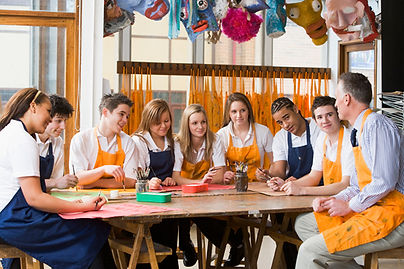PhD (Arts Ed), MTeaching, MMus (Perf), BMus, BMedSci (Hons)
DipModLang (German), ZMP (German) DELF B2 (French), Churchill Fellow

Standard 4
Create and maintain supportive and safe learning environments
4.1 Support student participation
PROFICIENT: Establish and implement inclusive and positive interactions to engage and support all students in classroom activities.
ANNOTATION AND EVIDENCE
The evidence for this focus area consists of lesson observation notes (Artefact 4A) from my Head of Department 2023 that document interactions with students, including using students names and listening positively to students, acknowledging students' contributions, allowing students to respond appropriately, being accessible to students, displaying equitable amounts of time and engagement with individuals, and exhibiting a caring attitude and showing interest in all students acknowledgement.
Artefact 4B shows the use of icy-pole sticks to ensure inclusive distribution of questions around the class so that all can participate. These are from the second school I worked at, and I have made a set for every class I have taught since then. One useful benefit of using them (which is rarely reported) is that it is an extremely efficient way of learning students' names.
4.2 Manage Classroom activities
PROFICIENT: Establish and maintain orderly and workable routines to create an environment where student time is spent on learning tasks.
ANNOTATION AND EVIDENCE
Artefact 4C: This piece of evidence is a document called "Classroom policies," which I wrote for my classes at IES College. The fact that the classes were very small seemed to make some students think that they had licence to behave in idiosyncratic ways with impunity.
If further evidence is required, I can request an email from my Head of Department (Music), who observed the way I took the roll (and conducted the beginning of each class). She was impressed and said that she was going to do her rolls in the same way from now on.
A third artefact could be supplied in the form of seating plans for various classes.
4.3 Manage challenging behaviour
PROFICIENT: Manage challenging behaviour by establishing and negotiating clear expectations with students and address discipline issues promptly, fairly and respectfully.
ANNOTATION AND EVIDENCE
Artefact 4C (above, under 4.2) shows implementation of school discipline and welfare policies and positive welfare/classroom practices that reflect school practices, including a range of strategies to manage classroom behaviour. The purpose of the document is to prevent behavioural issues in the first place, rather than simply waiting for them to occur.
Artefact 4D (right) is a de-identified email that I wrote to a parent to follow up with a student who had not handed work in on time and had not turned up to a tutorial he was required to attend. The subsequent phone call revealed a troubling and abusive relationship with a student in the same class, and the correspondence with the parent enabled me to be proactive in reducing the amount of time they spent in each other's company.

ARTEFACT 4E: Kagan cooperative learning cards and poster
This rich piece of evidence (two pictures to the right) shows a tool I created in collaboration with my supervising teacher to instigate a change in the way group work was undertaken in Year 8 music at the school where I attended my first SPE (2019). During the first part of my practicum, most of the lessons in Years 7, 8 and 9 consisted of project work in small groups. But there was a problem. The students didn’t know how to work in groups effectively. The workload was unevenly distributed and the students lacked skills and strategies in getting things done collaboratively and using their time wisely. With very few exceptions, the students were not working in a way considered to be cooperative by Johnson, Johnson and Smith (1998), such as sharing goals, being individually accountable, working to encourage and support each other, using good group skills or processing their learning together (p. 38). The more motivated students were tending to carry the majority of the load, while in many groups there was at least one student who was disengaged, distracting and/or disruptive. This behaviour continued despite rotating visits and guidance by the supervising teacher and me.
I consulted with the supervising teacher and offered some of the strategies I had learned in my studies and in resources I found in the classroom (Heath, 2010; Kagan & Kagan, 2015). She encouraged me to implement and experiment with some of them.
I taught the various roles of Kagan and Kagan’s cooperative learning (2015) using a cooperative learning strategy: a small group/full class jigsaw activity to teach the language and job of each role. See the image of the whiteboard at the end of the activity, after every student had contributed to the table. See photograph below, "How do committees work?"


4.4 Maintain student safety
PROFICIENT: Ensure students’ wellbeing and safety within school by implementing school and/or system, curriculum and legislative requirements.
ANNOTATION AND EVIDENCE
Artefact 4F: Hat policy incident email
This piece of evidence shows the beginning of a conversation I had with a house dean about students not complying with the rule of wearing a hat while outdoors. This rule is designed to protect the skin of the students and is important to their long-term well being. I followed up the email with an in-person conversation, and the dean confirmed that he uses a similar strategy (with respect to the list) and had spoken to the student about the matter.

.png)